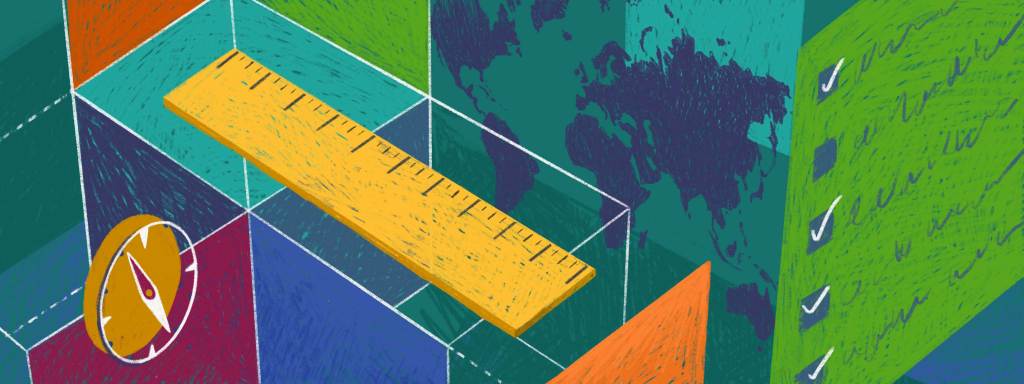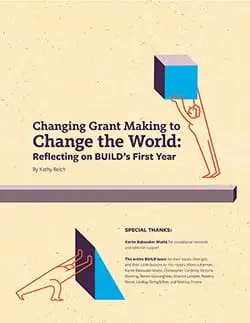
In 2016 I joined the Ford Foundation as its first BUILD director, to lead a new six-year, $1 billion initiative to help organizations that are moving the needle on inequality become stronger, more sustainable, and more durable. We’re now a third of the way through BUILD’s six-year time frame, and we have learned a lot along the way. In the spirit of transparency and shared learning, our new report, Changing Grant Making to Change the World, which we’re publishing in partnership with Rockefeller Philanthropy Advisors, offers a set of early lessons we think can help other grant makers who are interested in changing entrenched systems and supporting nonprofit sustainability.
In the first 18 months of BUILD, I hired a seasoned team and together we codified a theory of change, developed an evaluation and learning framework, crafted a technical assistance strategy to benefit BUILD grantees, rolled out a multilingual organizational assessment, and trained hundreds of Ford Foundation staff. Most importantly, we worked collaboratively with that staff to make more than 200 BUILD grants that span the range of nonprofits around the world.
Advocacy organizations, grassroots mobilizers, think tanks, litigators, intermediaries, narrative change organizations—all are represented within the BUILD cohort. The largest organization has an annual budget of over $200 million, while the smallest has less than $200,000. BUILD grantees are based in 27 countries—and counting. Once invited to join the program, BUILD grantees receive five years of generous funding, including both general support and core support dedicated to institutional strengthening.
While purposeful, this diversity also poses significant challenges. We wondered: Could BUILD actually serve so many different kinds of organizations, and do so with quality? With no common baseline, how would we evaluate success? Would grantee organizations embrace BUILD? What about the foundation’s own program staff?
Eighteen months later, we may not have all of the answers, but Changing Grant Making to Change the World highlights six important early lessons:
Nonprofits thrive with larger, longer, more flexible grants.
General support is great for organizations. It provides vital working capital to sustain and improve their infrastructure. It also allows organizations to spend more time and resources on programming, planning for the longer term, and responding more quickly to new challenges or opportunities.
Long-term, flexible grants work best when they closely align with strategy.
Our experience has shown us the importance of starting by considering the ultimate goal—the system we’re trying to change, the policy win we’re trying to achieve, the community we’re trying to empower—and then give BUILD support to grantees who are key partners in achieving those goals.
Grants like these can foster deeper relationships between grant makers and the organizations they support—but money can’t buy trust.
In addition to its immediate practical benefits, we believe that providing general operating support, combined with thoughtful institutional strengthening, can improve the power dynamic between funders and grantees. By acknowledging and supporting the true costs of doing business, funders can give their grantees the space and trust to choose their own priorities and to be frank about their needs.
Grants like these can work anywhere in the world.
With 90 BUILD grantees in 26 countries outside the US, we have seen plenty of evidence that even amid complex financial situations or political contexts, grantees are able to make good use of their BUILD funds.
Supporting institutions is critical—but so is catalyzing and supporting networks.
We believe networks offer unique advantages in advancing long-term social change: They can help funders and nonprofits by weaving social ties, accessing new and diverse perspectives, openly building and sharing knowledge, creating infrastructure for widespread engagement and coordinating resources and action.
Patience is a virtue. So is rigorous evaluation.
We’ve always said that BUILD is an experiment—we will learn as we go. Learning and evaluation, in partnership with external evaluators, will enable us to share our experience internally at Ford, with BUILD grantee partners, and with the wider audience of grant making, evaluation, and capacity-building practitioners.
I delve deeper into these lessons—with specific anecdotes, testimonials, and insights—in the full report. I hope you’ll explore and engage with it, and stay tuned for more of what we’re learning as the BUILD initiative continues to develop.

